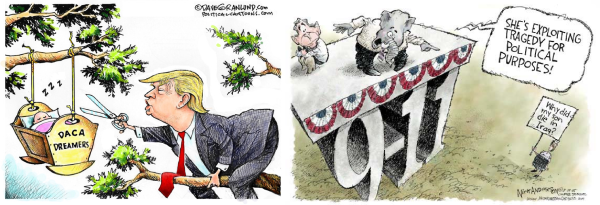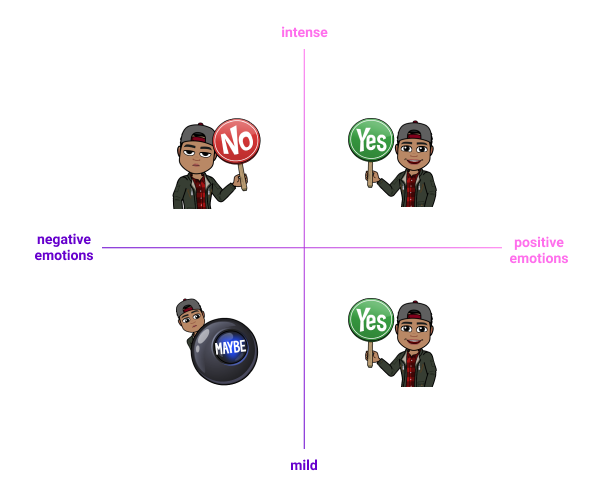A unified theory of Bitmoji psychology
Imagine your friend just texted you with some bad news—their grandfather recently passed away. Would you feel comfortable responding with a Bitmoji? Now imagine your friend just texted you to tell you that they scored their dream job. How would you feel about replying with a Bitmoji? If you’re anything like me, you’d steer clear of Bitmoji after hearing bad news, but wouldn’t hesitate to send a congratulatory Bitmoji (or several).
Why can Bitmoji be used to convey genuine positive emotions, but not genuine negative ones?
The back story
Bitmoji began life in 2008 as Bitstrips—a service that was allowed anyone to create their own comic strips. Its designer, a Toronto-based comic book artist named Jacob Blackstock, said he thought of the service as the “groundwork for a whole new way to communicate” and a “medium for self-expression.” Bitstrips was first adopted by schools in Ontario, where it was used as a teaching tool in language classes. The company spun out Bitmoji in 2014, which allowed users to create personalized stickers for use in messaging apps. This is the service we know and love today.
No room for negativity
I’m tempted to say that cartoons simply cannot contain genuine negative emotions. They’re too silly and inherently unserious. But throughout history, political cartoons have been effectively used to communicate deeply negative ideas about society.
Consider these two cartoons—one about George W. Bush’s politics in the wake of 9/11, the other about Trump’s decision to end DACA. These are both very serious and emotionally charged issues that are conveyed effectively in cartoon form.

No shortcuts
Maybe negative Bitmojis lack authenticity because they were created by somebody else. When you send a Bitmoji, you’re copying and pasting another person’s design instead of coming up with a response of your own. When we’re sad, we don’t want to feel like our friends are taking shortcuts on the route to consoling us. This seems plausible, but it can’t be the whole story because we don’t feel equally offended by the lack of effort involved in sending a super positive Bitmoji.
Nuancing the negative
Perhaps we’re painting with too broad a brush. Are some types of negative emotions more amenable to Bitmoji than others? Let’s investigate. Here’s a Bitmoji that I’ve seen friends use in a serious way:

And here’s a Bitmoji that I can’t imagine anyone using in a serious way:

What’s the difference that makes a difference? The first Bitmoji describes an internal mental state. It’s negativity that you’re feeling inside your own head. The second one is negativity directed at someone else—an insult. Maybe we can say that it feels appropriate to communicate your mood with Bitmoji, but strange to communicate a negative message that’s not about you (e.g. a personal attack, a consolation message).
This isn’t quite right either! It’s not weird to send a “Get well soon” Bitmoji to someone who has a cold, but it is weird to send a “I’m so sorry” Bitmoji to someone whose grandparent has died.
Re-enforcement vs. counteraction
It seems like the communication norms that govern positive interactions are markedly different than the ones that govern negative interactions.
There are two types of responses in the realm of the negative: re-enforcement and counteraction. Re-enforcement is, “Wow, yeah, that does suck.” Counteraction is, “Cheer up, it’s going to be okay.” The intensity of the emotions determines whether you should use counteraction or re-enforcement. It’s usually okay to use counteraction when the emotions are more mild (e.g. they had a bad day at work). But it’s a big faux pas to use counteraction when the emotions are severe (e.g. they recently lost a loved one).
My theory is that Bitmoji is almost always received as counteraction because the cartoonish form is inherently pretty comical. This means that the acceptability of Bitmoji use in negative situations is sensitive to the intensity of the emotions, whereas the appropriateness of Bitmoji use in positive situations is not.
In other words, it’s okay to send a happy Bitmoji in response to mildly good news (“I found a dollar on the sidewalk!”) and extremely good news (“I got engaged!”). But you should only send a sad Bitmoji in response to mildly bad news (“I have a cold”, not “I have cancer”).

Positive emotions are much easier to respond to (and much more appropriate for Bitmoji) because re-enforcement is almost always the right approach. When responding to negative emotions, you often have to choose between the lesser of two evils: re-enforcement or counteraction. Sometimes one is better than the other, but they’re both pretty awful. It’s not fun to have your emotions invalidated (“There’s nothing to worry about"), but it’s also unpleasant to spiral deeper into negativity (“Yup, that sucks”).
A matter of time
Anecdotally, people are pretty comfortable using regular emojis (😔) to convey genuine, negative emotions, even in response to more serious news. Emojis function more like punctuation and less like cartoons. But maybe that’s just because we’re more used to them. They’ve been around longer. It’s possible that this essay would make no sense to a 9th grader who uses Bitmojis liberally—no matter how intense the situation. The novel becomes normal. And it wouldn’t surprise me if the first users of SMS (or writing, for that matter) were skeptical about its capacity for emotion.